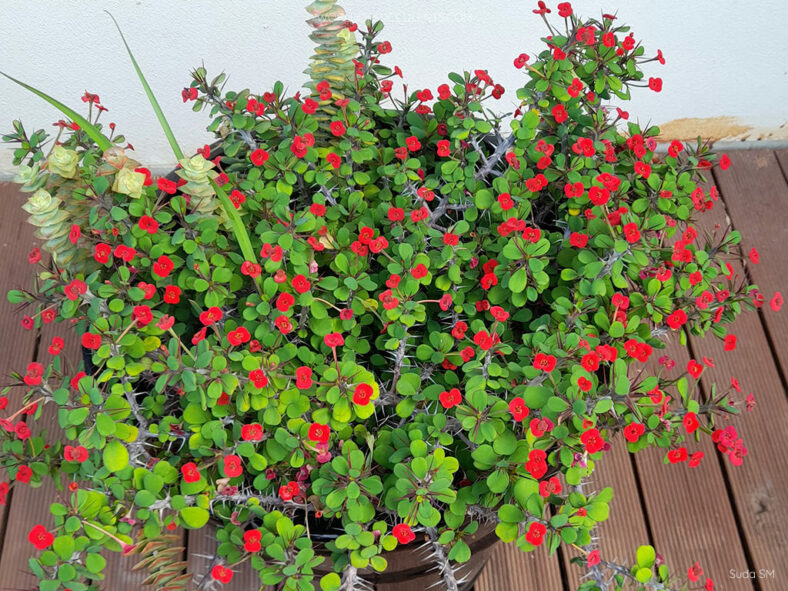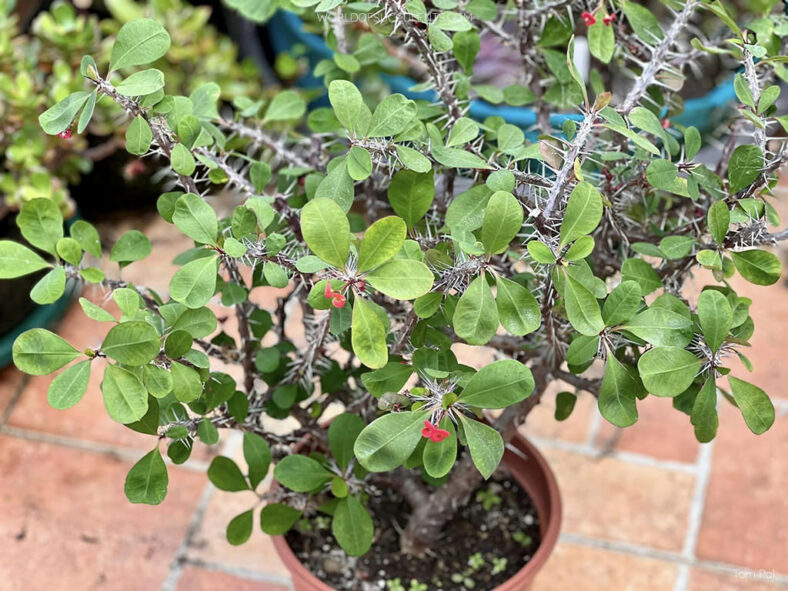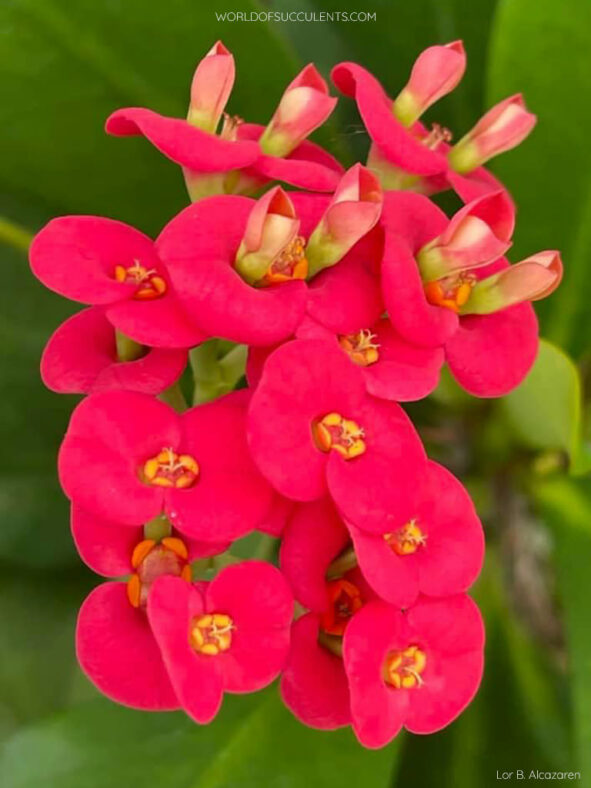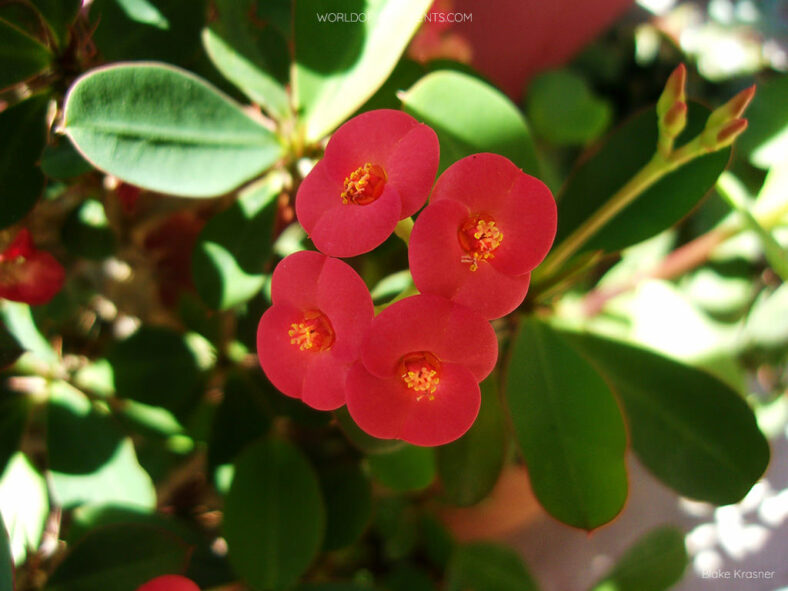Euphorbia milii is an extremely popular ornamental shrub that can be found in gardens and homes all over the world.
Scientific Name
Euphorbia milii Des Moul.
Common Name(s)
Christ Plant, Christ Thorns, Crown of Thorns, Siamese Lucky Plant
Synonym(s)
Euphorbia milii var. milii
Scientific Classification
Family: Euphorbiaceae
Subfamily: Euphorbioideae
Tribe: Euphorbieae
Subtribe: Euphorbiinae
Genus: Euphorbia
Etymology
The specific epithet "milii (MIL-ee-eye)" honors Baron Milius (1773-1829), once Governor of Réunion (formerly known as Bourbon), who reportedly introduced this species into cultivation in France in 1821.
The common name "Crown of Thorns" refers to the belief that the crown of thorns Jesus Christ was forced to wear at his crucifixion was made from stems of this plant.
Origin
Euphorbia milii is native to Madagascar but is now widely cultivated elsewhere.
Description
Euphorbia milii is a succulent shrub with many woody, branched, and densely spiny stems. In cultivation, it typically grows up to 3 feet (0.9 m) tall but can reach up to 6 feet (1.8 m) in its natural habitat. The stems are obscurely 3- to 5-angled and range in color from brown to greyish. The spines are grey to brown, measuring up to 1 inch (2.5 cm) long. They are arranged in spirals or indistinct rows, either solitary or in groups of three. The leaves are green and obovate and can grow up to 2 inches (5 cm) long and 0.7 inches (1.8 cm) wide. They drop as they age and are mainly found on new stem growth.
The plant produces flowers all year round, primarily in spring and summer. The inconspicuous greenish true flowers, borne in cyathia, are subtended by long-lasting, usually bright red (pink, white, or yellow in some cultivars), exceptionally showy bracts. The fruits are 3-lobed capsules that contain gray-brown seeds.

How to Grow and Care for Euphorbia milii
Light: Providing your Euphorbia milii with plenty of sunlight is important for optimal growth. Place it near a sunny window or move it to your balcony or garden during the warmer months, gradually increasing sun exposure to avoid sunburn.
Soil: Use a well-draining soil, either a commercial potting mix formulated for succulents or create your own well-draining soil.
Temperature: While high summer temperatures are not a problem, low winter temperatures can damage or kill your plant. Euphorbia milii grows best in USDA Plant Hardiness Zones 10a to 11b, with average minimum winter temperatures ranging from 30 to 50 °F (-1.1 to 10 °C).
Watering: From spring to fall, water the plant when the soil's top inch (2.5 cm) feels dry. Reduce watering in winter and give it just enough water to prevent wilting. In the warm season, evening is the best time of the day for watering.
Fertilizing: To ensure the potted plant receives sufficient nutrients, apply a balanced fertilizer in a 10-10-10 NPK formulation, diluted to 1/4 strength weekly during the growing season.
Repotting: Although your Euphorbia milii does not need to be repotted often, it will benefit from repotting when it outgrows its pot. The repotting is best done in early spring at the beginning of the growing season. Wear gloves, protective clothing, and appropriate eye protection when handling this plant.
Propagation: The easiest and quickest way to propagate this plant is by stem cuttings. Although it can be started from seeds, it can be difficult for them to germinate. Take cuttings during the growing season. Spring is the best time to sow seeds.
Learn more at How to Grow and Care for Euphorbia.
Toxicity of Euphorbia milii
Euphorbia milii produces a poisonous white milky sap that may cause burns or irritation if in contact with the skin or eyes. Therefore, keeping this plant away from children and pets is best.
Varieties, Forms, and Cultivars of Euphorbia milii
- Euphorbia milii var. roseana
- Euphorbia milii f. lutea
- Euphorbia milii 'Cristata'
- Euphorbia milii 'Primrose Yellow'
Links
- Back to genus Euphorbia
- Succupedia: Browse succulents by Scientific Name, Common Name, Genus, Family, USDA Hardiness Zone, Origin, or cacti by Genus
Photo Gallery
Click on a photo to see a larger version.


